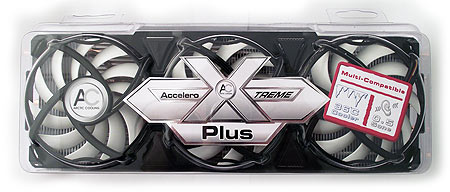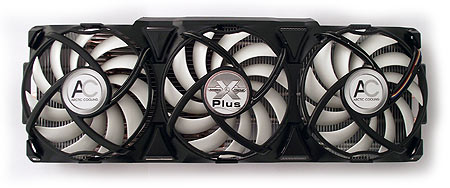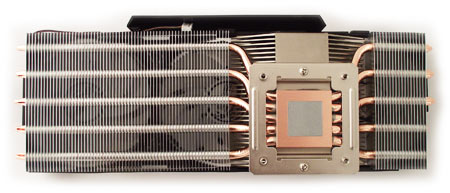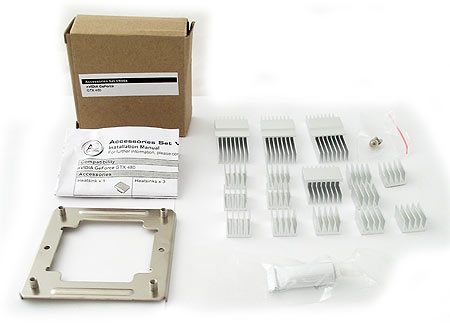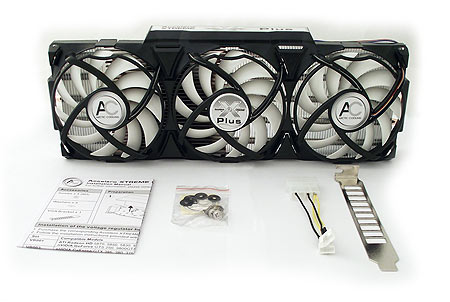Three Aftermarket Graphics Coolers On GeForce GTX 480
Today we're testing three of the largest graphics card coolers available: Arctic Cooling's Accelero XTREME Plus, DeepCool's V6000, and Zalman's VF3000F. Can these products bring performance to the table commensurate with their large triple-slot size?
Arctic Cooling Accelero XTREME Plus
The name’s a mouthful, isn’t it? Arctic Cooling’s Accelero XTREME has been around for a while now, and it has an excellent reputation for dissipating up to 250 watts of heat.
Instead of creating a separate SKU for each type of graphics card (such as the Accelero XTREME 5870), the company got wise and developed the Accelero XTREME Plus, a generic version that can fit most of the high-end hardware currently available with the purchase of the appropriate accessory set.
This is a big cooler, to be sure. Though, at 622 grams (~1 lb. 6.6 oz.), it’s a mere ounce heavier than Nvidia's reference GeForce GTX 480 cooler and the same weight as DeepCool’s V6000. At 56 mm wide by 104 mm tall by 290 mm long, it is the longest cooler in our roundup, exceeded only the reference model.
The Accelero XTREME Plus boasts a total of three 92 mm fans and five heatpipes. Arctic Cooling advertises 81 CFM of airflow. The cooling fins are aluminum, with a copper cooling block attached to copper heatpipes that pull the heat from the GPU. The fan shroud is plastic, but surprisingly sturdy.
For testing purposes, we’re putting this cooler on the hottest GPU available—the GF100 in Nvidia's GeForce GTX 480. And so we’re using the appropriate VR004 accessory set. The set costs $5.99 USD from arctic-cooling.com and includes a mounting plate, various heatsinks, an instruction sheet, and thermal adhesive. The Accelero XTREME Plus cooler costs $65.95 USD from the same site, so you’re looking at a total buy-in of about $72 to get what you need to cool the GeForce GTX 480 with this monster.
The package doesn’t contain all that much aside from the massive cooler. There is an instruction sheet, some mounting hardware, a fan power adapter (in case the supplied plug doesn’t fit the receptacle on your graphics card) and a VGA bracket.
With the reference GeForce GTX 480 cooler removed and the contact surfaces cleaned appropriately, the RAM and VRM heat sinks must be applied. Here, the Accelero XTREME Plus sets itself apart from the rest of the pack by requiring thermal adhesive to be used. On the plus side, thermal adhesive is quite effective. Conversely, it’s also quite permanent. This means that the cooler will be married to the graphics hardware for the life of the card. This isn’t a terrible thing, but it is a little disappointing for folks who like the idea of a generic heat sink that can migrate with them to their next purchase (especially after spending that much money on the aftermarket upgrade).
Get Tom's Hardware's best news and in-depth reviews, straight to your inbox.
After the RAM and VRM sinks are glued, the cooler can be outfitted with the correct mounting bracket. And after this, the whole assembly is attached to the graphics card with four screws. No thermal paste application is necessary as the cooler comes prepared with a film of Arctic MX-2 premium thermal paste. The power plug conveniently fits into the stock GeForce GTX 480 fan header, making for a nice, clean installation.
With the cooler installed, the card now takes up three expansion slots. If you plan a dual-card SLI or CrossFire configuration, make sure your motherboard has enough space between its onboard connectors to handle a couple of cards equipped with these coolers.
Current page: Arctic Cooling Accelero XTREME Plus
Prev Page The Quest For A Bigger Gun Next Page DeepCool V6000Don Woligroski was a former senior hardware editor for Tom's Hardware. He has covered a wide range of PC hardware topics, including CPUs, GPUs, system building, and emerging technologies.
-
AMW1011 Wow, I can't believe the Accelero and the Zalman were basically neck and neck, with no tangible victory in cooling. I always thought the Accelero would be better, but Zalman actually pulled this one off.Reply
However, what would be AMAZING, is to have a follow-up to see which of these two solutions work best in SLI, assuming EITHER work well in SLI. I think that is the big question, especially since we never expected bad temps.
Also can you please add the voltages used for each overclock? It might give people, especially stock GTX 480 owners, a better idea of what these can handle, since cards will always vary when overclocking.
Holy ***, stock voltages! That is crazy! Please post up your VID (stock voltage) for us. Either you have a golden GTX 480, or the VID is a lot higher than it needs to be, which is pretty common.
Great article, I love to see these kind of side articles/reviews, and it was well done. -
Nerdbox87 Given that this entire article is based on cooling you really should have included all GPU temps - as vram / vrm cooling may be the difference between the Accelero and the Zalman (as I know my Accelero Twin Turbo on a 5850 struggled with vram temps in Furmark)Reply
On this my guess would be the Zalman would smash it -
joytech22 How was the 480 at just under 60C when my 470's are always idling at 86C in a Antec twelve hundred..?Reply
I mean sure this case isn't the best cooling case but there's never really much hot air in the case and with a sidepanel fan blowing on the two cards i just cant see how.
Unless.. you guy's test in a cool room at about 15-20C or the fan speeds are maxed 100% of the time. -
dvijaydev46 Oh, Zalman's cooler looks weaker than Accelero but the later actually outperforms a bit. That's amazing.Reply -
Th-z Don, what is your view on how to apply thermal paste. There are numbers of ways people talk about: a pea in the middle, several peas, line in the middle, several lines, and old school spread method. You use spread method when you apply the RAM/VRM sink on Zalman, I presume you use the same method on other parts, too. Maybe Tom can do a comparison test on different ways of applying thermal paste.Reply -
compton These look good and would help me out quite a bit with a 465/470, but I wish I could get them in a design that would help maintain the existing footprint. My GF100 doesn't run quite as hot as some reference card designs, but that sure as hell doesn't mean that I'm happy with the leaf blower lurking in my case. Maybe I find a way to make the Zalman work.Reply -
avatar_raq I think the Zalman one wins here. It performs slightly better, costs slightly less, weighs less and is shorter than the Arctic cooler. As for noise they're trading blows. Being shorter, the VF3000 does not increase the length of the GTX 480, unlike the accelero which may theoretically cause incompatibility with some cases. Being lighter, it strains the PCB much less. The fact it performed so close to the Arctic cooler with only 2 fans surprised me.Reply
